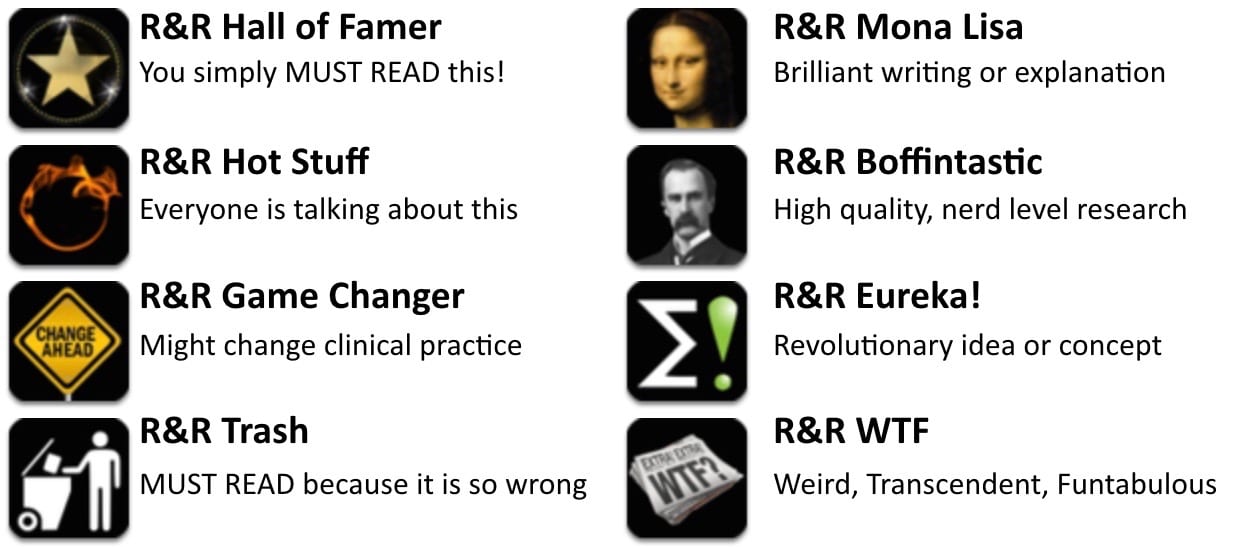R&R In The FASTLANE 123
Welcome to the 123rd edition of Research and Reviews in the Fastlane. R&R in the Fastlane is a free resource that harnesses the power of social media to allow some of the best and brightest emergency medicine and critical care clinicians from all over the world tell us what they think is worth reading from the published literature.
This edition contains 6 recommended reads. The R&R Editorial Team includes Jeremy Fried, Nudrat Rashid, Soren Rudolph, Anand Swaminathan and, of course, Chris Nickson. Find more R&R in the Fastlane reviews in the : Overview; Archives and Contributors
This Edition’s R&R Hall of Famer
Radmilo J Jankovic et al. Airway Trauma and Management. EC Anaesthesia 1.1 (2015): 2-7.
- Great review on airway management in direct airway trauma highlighting sub specialized procedures as submental intubation in maxillofacial trauma and mandibular trauma, fiber optic intubation in laryngotracheal injuries and the extremely challenging distal airway injuries and penetrating neck injuries.
- Recommended by Søren Rudolph
Laan DV et al. Chest Wall Thickness and Decompression Failure: A Systematic Review and Meta-analysis Comparing Anatomic Locations in Needle Thoracostomy. Injury 2015; PMID 26724173
- Traditionally, it is recommended to perform needle decompression in the 2nd intercostal space, mid-clavicular line. However, recent studies suggest that the average chest wall thickness at this location makes it less likely that the catheter will reach the pleural space and thus, may not decompress the chest adequately. This systematic review/meta-analysis looks at 16 articles and determined that the 4th/5th intercostal space the anterior axillary line has the lowest predicted failure rate. The vast majority of the data is anatomical (from radiology studies or cadavers) instead of clinical but nonetheless, it makes sense to consider an alternate approach.
- Recommended by Anand Swaminathan
Wong A et al. Evaluation of adjunctive ketamine to benzodiazepines for management of alcohol withdrawal syndrome. Ann Pharmacother 2015; 49:14-19. PMID 25325907
- Multiple agents are currently being studied as adjuncts to benzodiazepines for treatment of alcohol (ethanol) withdrawal syndrome (AWS). Ketamine is of particular interest given its favorable safety profile and physiologic plausibility of antagonism at the NMDA receptor, which is upregulated in AWS. This small retrospective study found adjunct use of ketamine to be safe and to trend towards a reduction in benzodiazepine requirements in the setting of AWS. Although very few conclusions can be drawn from this small study (reduction in benzodiazepine dose was not statistically significant), it fuels interest for what may ultimately be a valuable adjunct tool in the treatment of AWS.
- For further reading on the American College of Medical Toxicology’s policy on AWS
- Recommended by Meghan Spyres
Shankar-Hari M et al. Judging quality of current septic shock definitions and criteria. Crit Care 2015; 19(1):445. PMID 26702879
- A critical evisceration of the current Surviving Sepsis Campaign/ Sepsis Consensus Conference definitions of sepsis syndromes. The approach the authors use for the assessment of validity is worth reflecting upon, as it can be applied to other syndrome definitions and diagnostic tests. Hopefully the soon-to-be-published ‘Sepsis 3.0’ definition will serve us better.
- Recommended by Chris Nickson
Chouliaras et al. Pneumomediastinum following blunt trauma: Worth an exhaustive workup? J Trauma Acute Care Surg 2015; 79(2): 188-92 . PMID 26218684
- Pneumomediastinum on CT and/or CRX following trauma is a fairly common finding in blunt chest and neck injuries and poses a diagnostic dilemma due to the high cost of missed injury vs the high cost of unnecessary aggressive workup with bronchoscopy and esophageal imaging and possible injury during that workup.This six-year retrospective case report on the incidence of aero-digestive injuries in blunt trauma to the chest and neck attempts to answer this dilemma. Unfortunately only 4 (2,6 %) patients were found between 258 patients with pneumomediastinum. Furthermore ¾ of these were of iatrogenic origin, so really only one patient was identified! The vast majority (72%) of patients with mediastinal air in this study population originated from PTXs and showed some air bubbles in the mediastinum away from aerodigestive structures.The numbers are obviously too small to make any recommendations. However, in the post paper discussion, the author offers his thoughts on which patients need a more extensive work up. When pneumomediastinum is located in proximity of aerodigestive structures, when no PTX can explain this air coupled with hemoptysis, odynphagia, hoarsness an aerodigestive workup with esophagogram, esophagoscopy and bronchoscopy is warrented. Also patients with excessive air leak through a chest tube require bronchoscopy to delineate the tracheobronchial airway injury.
- Recommended by Søren Rudolph
ato R et al. A review of sepsis-induced cardiomyopathy. J Intensive Care 2015; 3:48. PMID 26566443
- A well written hot-off-the-press review of sepsis-induced cardiomyopathy. While the prognostic implications remain controversial there are a few this we do know: it has rapid onset, resolves in 7-10 days in survivors, involves ventricular dilation with low filling pressures (due to increased compliance) and ejection fraction may be preserved despite impaired contractility if there is a vasoplegic shock state. Unlike Takotsubo cardiomyopathy, there should be no regional wall motion abnormalities. Treat sepsis and support the heart. Should we be using levosimendan and sparing the catecholamines? Dunno……
- Recommended by Chris Nickson
Senior Consultant Anesthesiologist, Traumemanager and PHEM doctor. Dedicated to trauma resuscitation, prehospital care and airway management. Barometerbarn | @SorenRudolph |






